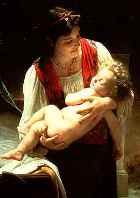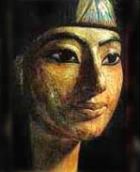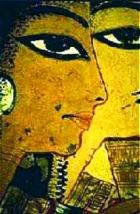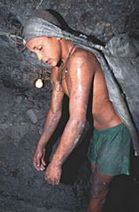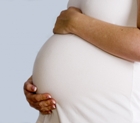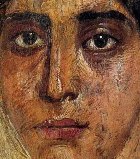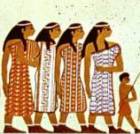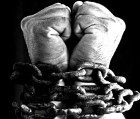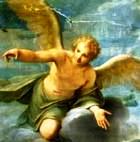Paintings: Sarah, Hagar, Abraham
What are the hidden meanings?
- An intact jug showed virginity; a broken vessel denoted loss of virginity
- Dishevelled clothes could mean dishevelled virtue
- Red meant passion or active sexuality
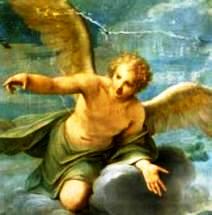
- White hair or beard denoted age and/or wisdom
- Angels were messengers of God and a sign that an act of providence would occur
- A raised hand with palm turned outwards means the person accepts no responsibility
- A dominating stance showed dominance in the relationship
- A ruined house pointed to a society in decay
- Note the body language, especially the hands and body position. Everything has a message.
Hagar is given to Abraham
‘Sarah presenting Hagar to Abraham’, Adriaen van der Werff, 1699
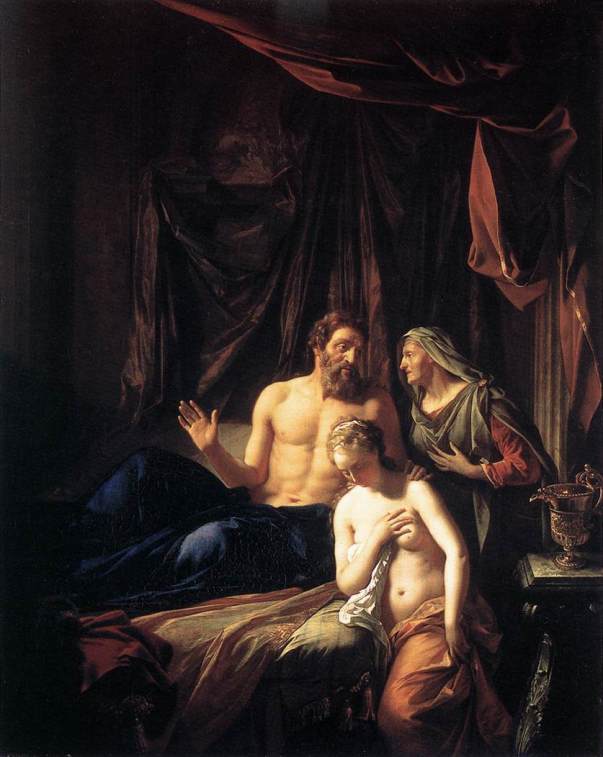
Sarah offers an uncertain Hagar to her husband Abraham.
Any child resulting from this union would belong to Sarah, since Hagar was her personal slave. On the other hand, if Hagar plays her cards well she might become the favored concubine of the tribal leader, rather than a mere slave.
Tremendously successful during his lifetime, van der Werff knew the value of eroticism. Unlike other painters, he portrayed Abraham as virile and handsome. Poor Sarah, on the other hand, is well past her use-by date. No subtlety here, folks…
See Slavery in the Bible for information about slaves and rules governing their treatment.
Bible reference: Book of Genesis, 16:1-3
The pregnant Hagar is expelled
‘Hagar Leaves the House of Abraham’,
Peter Paul Rubens, 1615- 1617
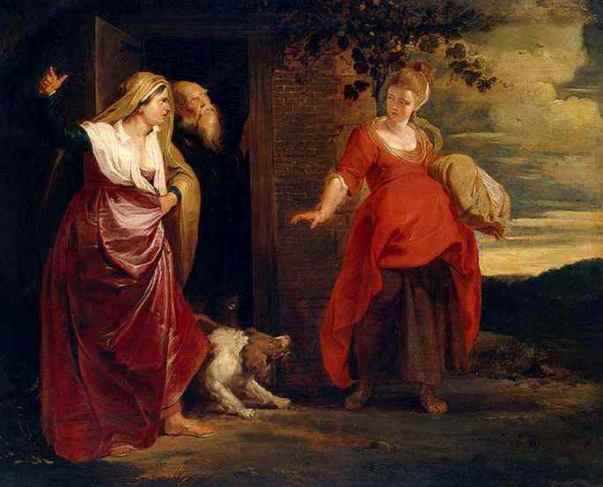
The rich fabric of Sarah’s gown and the voluptuous red of Hagar’s says it all.
- Sarah has power and wealth.
- Hagar has youth, sexual allure and an unborn child.
Clearly, Sarah cannot stand the sight of her. She drives her slave out like a stray dog that has overstayed its welcome. An ineffectual Abraham stands half-in, half-out of the doorway.
Rubens excelled at painting voluptuous goddesses and here are two more of them, albeit in the form of biblical heroines. The painting is in-your-face sensuous, with human passions all too visible. Rubens’ luminous colors suggest the emotional energy of the scene: Sarah’s murderous jealousy and Hagar’s perplexed, conciliatory gesture.
Bible reference: Book of Genesis 16:5-6
‘Expulsion of Hagar’,
Giovanni Battista Tiepolo, 1719
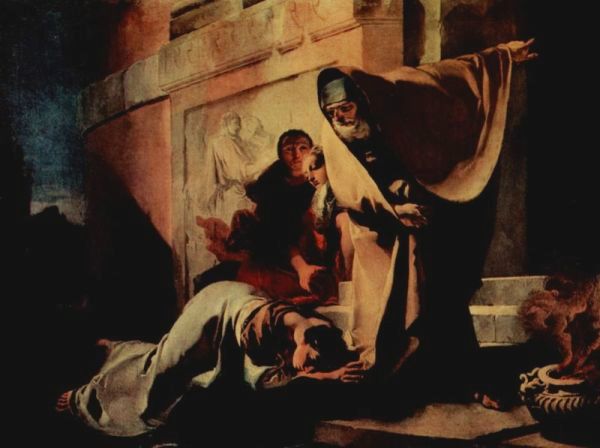
Tiepolo’s beautiful, terrified Hagar begs for mercy, but Abraham is unyielding: she must leave, and leave now. He towers over her prostrate figure: he is the one with the power and she, despite her beauty, has lost the influence she once had.
The background details of the painting seem curiously wrong for nomadic tribes-people, but they do suggest the wealth and power of Abraham, and the almost divine status of certain biblical figures in Western culture.
As a painter, Tiepolo was an international star, famous and pampered by the royal courts of Europe — the 18th century equivalent of a rock-star.
Bible reference: Book of Genesis 21:14
‘Hagar Weeping’,
Gerbrand van den Eeckhout, 1640’s
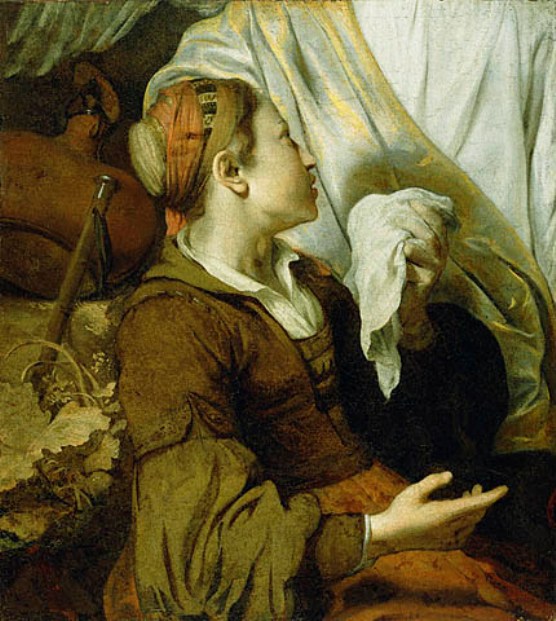
This painting was cut from a larger canvas, so we have only part of the original scene. Is this Hagar’s first flight from Sarah, or is it fourteen years later when she is cast into the desert with her son?
I would guess it is the former, since Hagar seems to be a young girl in this painting, rather than a mature woman. She is turning to look up at the angel behind her, the positioning of her beautiful hand suggesting that she is taken aback by what she sees.
Van den Eeckhout was another of Rembrandt’s pupils, probably studying with him in the late 1630’s. But the style of this painting shows he had moved away from Rembrandt’s influence and was painting images clearer and more precise than his teacher’s.
Bible reference: Book of Genesis 16:7-12
The Angel helps Hagar
‘Hagar and the Angel’, Nicolas Poussin, 1660
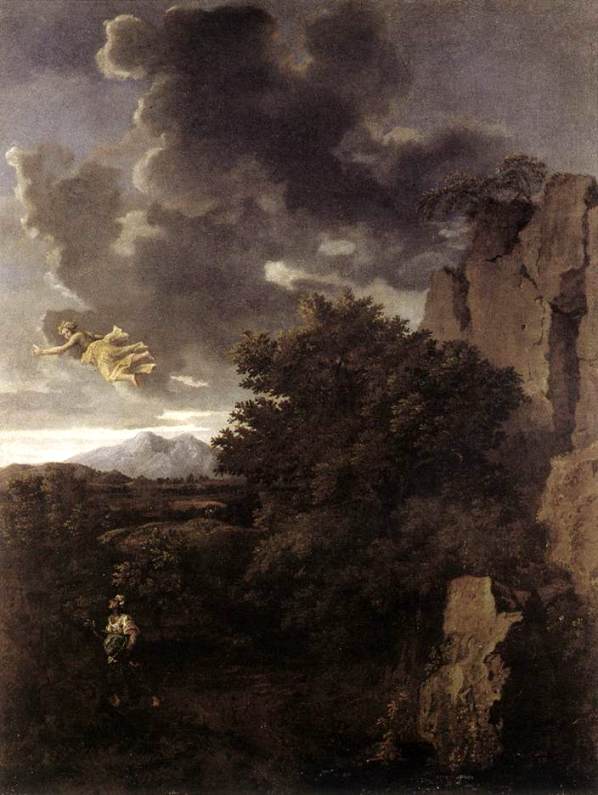
Hagar, almost lost in the immensity of Nature, senses the presence above her of a messenger from God. There are storm clouds ahead. She looks upwards, straining to understand what the Angel is saying.
The Angel urges her away from the towering rock cliff, back towards the clear blue sky and the land she has fled. One of my favorites.
Poussin, one of the greatest Baroque painters, was a poor boy made good. Born to an impoverished family, he trained in Paris then went to Rome, where he lived for most of his life. He returned briefly to Paris and was honored by Louis XIII, but the bitter jealousy that this caused made him decide to return to Rome in 1643. During his lifetime he was a respected intellectual, and after his death he influenced painters such as Jacques-Louis David, Cézanne and even Picasso.
Some interesting trivia: one of Poussin’s main patrons was Cardinal Richelieu, whom most people know as the villain in Dumas’ ‘Three Musketeers‘.
Bible reference: Book of Genesis 16:8-12
Abraham expels Hagar and Ishmael
‘Abraham repudiates Hagar’,
Lucas van Leyden
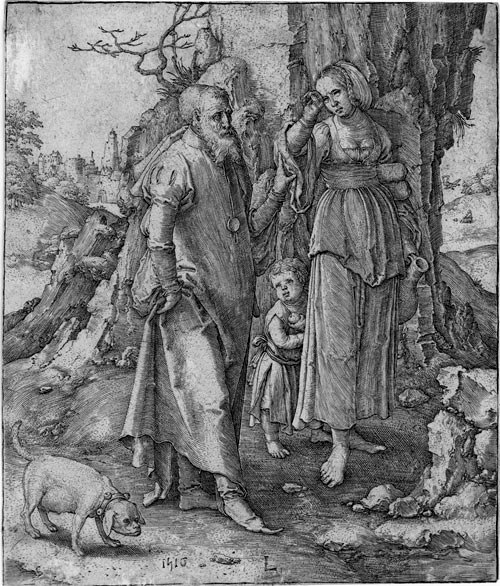
Hagar’s face shows exhaustion and weary reproach, her eyes swollen with crying. Her little child cowers behind her for protection. Interestingly, it is not only Hagar and her little child who are suffering – van Leyden has given Abraham an expression full of doubt and regret.
Though he made some paintings, van Leyden was mostly known for his engravings, which were of remarkably fine quality. He knew Dürer, who made a drawing of him, and was admired by Rembrandt.
His mastery of perspective is superb – look at the depth he is able to achieve on the flat surface of this picture of Abraham and Hagar.
Bible reference: Book of Genesis 21:14
‘Hagar Expelled’, Jan Victors
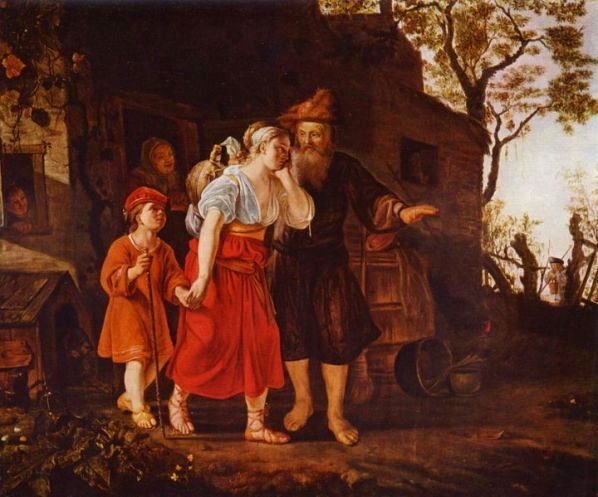
Abraham expels Hagar and her son from his home, a piteous scene, but notice that she is moving away from darkness and towards light – this, despite the apparent hopelessness of her situation.
Sarah stands at the doorway, a mean-spirited gleam in her eyes.
Victors painted biblical scenes for Calvinist (Protestant) patrons, pictures infused with his own religious beliefs and designed to encourage enquiry and discussion. He used rich colors and theatrical settings to engage the interest of viewers and lead them towards awareness of God’s continuing constancy and protection.
After the mid-1650’s, Victors did a surprising thing: he gave up painting to devote himself to caring for the sick, and he died in the East Indies (modern-day Indonesia) in 1676.
Sources give the year of this painting as 1635, but this would make Victors’ only 16 at the time. It seems a very accomplished work for such a young artist. But maybe he was an extraordinary young man…
Bible reference: Genesis 21:14
‘Abraham Casting Out Hagar and Ishmael’, Il Guercino (‘the man with the squint’).
His original name was Giovanni Francesco Barbieri. 1657
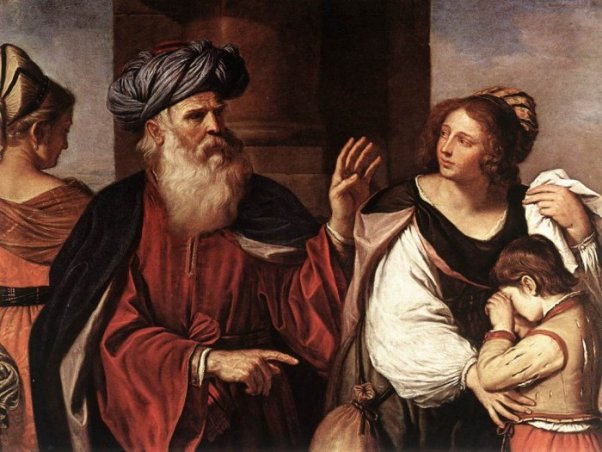
Abraham raises one hand in a gesture of rejection. With the other, he points in the direction that Hagar and their little son must go – out into the unforgiving desert.
- Hagar looks reproachfully at Abraham – she knows she and her child are being treated unjustly.
- Sarah pointedly turns her back on what is happening.
Il Guercino’s paintings are like watered-down Caravaggios. They have luscious colouring and consummate technique, but they somehow lack the impact of a Caravaggio painting, that ability to reach out and smack us in the eye. Nevertheless, they are beautiful, balanced, and perhaps more quietly thought-provoking.
Bible reference: Genesis 21:14
‘The Expulsion of Hagar’,
Adrien van der Werfft
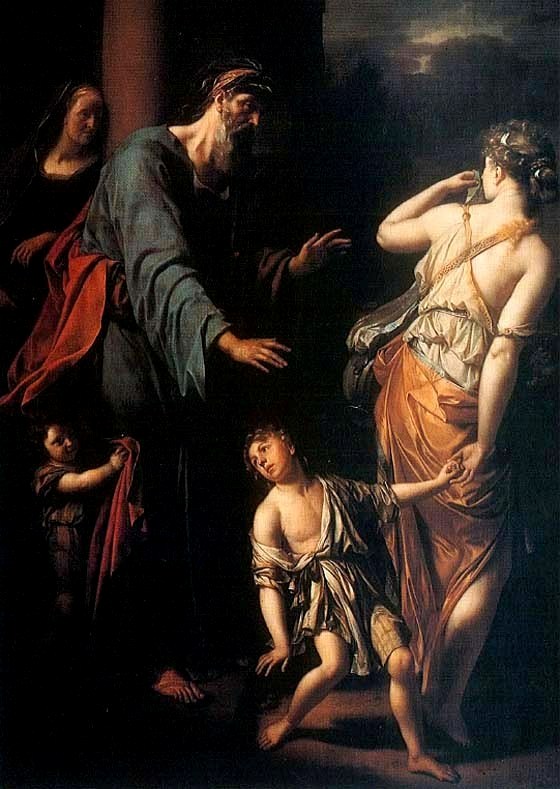
Notice the graceful curve of Hagar’s body. Abraham reaches out to her as she moves reluctantly away from him. Sarah stands immovable in the shadows.
This painting makes an interesting suggestion: that the quarrel was between the adults, but not the children:
- Little Isaac offers his own cloak to his brother Ishmael as the older boy and his mother are ejected into the wilderness.
- Ishmael turns back not to his father Abraham but to his little brother.
The story: Hagar alone and pregnant
Hagar was a lovely young slave belonging to Sarah, the powerful wife of Abraham.
Sarah had never had a child, so she decided to give Hagar to her husband, to be a surrogate who would have his child. Legally, the child would belong to Sarah and be Abraham’s heir, and Hagar could do all the hard work of bearing and looking after the baby.
Everything went to plan, and Hagar became pregnant. But the girl did not know her place, was not as subservient to Sarah as she should have been. Airs and graces, thought Sarah.
The former queen-bee of the tribe felt threatened, probably quite frightened of the power this former slave now had. It was not just that she resented the ‘nouvelle’. This girl might be carrying the future head of the tribe, and if so she would replace Sarah as chief woman in the tribe.
Sarah realized she had lost control of the situation.
We don’t know exactly what Sarah did to Hagar – the Bible just says she ‘mistreated’ her, but the heavily pregnant girl fled out into the wilderness, apparently trying to return to her family in Egypt.
On the way, beside a spring of water, she had some sort of mystical experience. An angel appeared to her, blessed her, and told her to return to Abraham. The angel promised that a great people would arise out of the tiny baby she carried in her womb.
So Hagar returned to Abraham’s house, and had a son whom she named Ishmael. For a while there was an uneasy truce between the two women. The boy grew up, and Abraham circumcised Ishmael when he was thirteen.
The next year, to the astonishment of everyone, Abraham’s aged wife Sarah became pregnant with his second son, Isaac. As soon as she held the longed-for baby in her arms the rivalry between the two women flared up again, and quickly became intense.
After a public brawl between the two women, Sarah demanded that Hagar and her young son be expelled from the tribe and cast out into the desert – a virtual death sentence. Abraham provided Hagar and her child – his own son – with bread and a bottle of water and sent them to their fate. It seems a very strange thing to do, and says a lot about Sarah’s power over Abraham…
They soon ran out of water and began to die. Hagar could not bear to watch her son dying of thirst, so she put him under the only shade she could find and crawled away to die. But again an angel appeared to help her, showing her a spring of water. She and the boy were saved, and lived on in the wilderness of Paran, where Ishmael became an expert in archery.
Hagar never returned to the tribe. When the time came she arranged that her boy marry an Egyptian woman, not a Hebrew.
He had many sons, who in turn founded many tribes that settled in all the area from Assyria to the northern border of Egypt. Hagar is seen as the foremother of the Arab nations.
The Bible text
The Birth of Ishmael (the Slave Girl’s story): Genesis 16
1 Now Sar’ai, Abram’s wife, bore him no children. She had an Egyptian maid whose name was Hagar; 2 and Sar’ai said to Abram, “Behold now, the LORD has prevented me from bearing children; go in to my maid; it may be that I shall obtain children by her.” And Abram hearkened to the voice of Sar’ai. 3 So, after Abram had dwelt ten years in the land of Canaan, Sar’ai, Abram’s wife, took Hagar the Egyptian, her maid, and gave her to Abram her husband as a wife. 4 And he went in to Hagar, and she conceived; and when she saw that she had conceived, she looked with contempt on her mistress.
5 And Sar’ai said to Abram, “May the wrong done to me be on you! I gave my maid to your embrace, and when she saw that she had conceived, she looked on me with contempt. May the LORD judge between you and me!” 6 But Abram said to Sar’ai, “Behold, your maid is in your power; do to her as you please.” Then Sar’ai dealt harshly with her, and she fled from her.
7 The angel of the LORD found her by a spring of water in the wilderness, the spring on the way to Shur. 8 And he said, “Hagar, maid of Sar’ai, where have you come from and where are you going?” She said, “I am fleeing from my mistress Sar’ai.” 9 The angel of the LORD said to her, “Return to your mistress, and submit to her.” 10 The angel of the LORD also said to her, “I will so greatly multiply your descendants that they cannot be numbered for multitude.” 11 And the angel of the LORD said to her, “Behold, you are with child, and shall bear a son; you shall call his name Ish’mael; because the LORD has given heed to your affliction. 12 He shall be a wild ass of a man, his hand against every man and every man’s hand against him; and he shall dwell over against all his kinsmen.”
13 So she called the name of the LORD who spoke to her, “Thou art a God of seeing”; for she said, “Have I really seen God and remained alive after seeing him?” 14 Therefore the well was called Beer-la’hai-roi; it lies between Kadesh and Bered. 15 And Hagar bore Abram a son; and Abram called the name of his son, whom Hagar bore, Ish’mael. 16 Abram was eighty-six years old when Hagar bore Ish’mael to Abram.
The Birth of Isaac: Genesis 21:1-7
1 The LORD visited Sarah as he had said, and the LORD did to Sarah as he had promised. 2 And Sarah conceived, and bore Abraham a son in his old age at the time of which God had spoken to him. 3 Abraham called the name of his son who was born to him, whom Sarah bore him, Isaac. 4 And Abraham circumcised his son Isaac when he was eight days old, as God had commanded him. 5 Abraham was a hundred years old when his son Isaac was born to him. 6 And Sarah said, “God has made laughter for me; every one who hears will laugh over me.” 7 And she said, “Who would have said to Abraham that Sarah would suckle children? Yet I have borne him a son in his old age.”
Hagar and Ishmael Sent Away: Genesis 8-20
8 And the child grew, and was weaned; and Abraham made a great feast on the day that Isaac was weaned. 9 But Sarah saw the son of Hagar the Egyptian, whom she had borne to Abraham, playing with her son Isaac. 10 So she said to Abraham, “Cast out this slave woman with her son; for the son of this slave woman shall not be heir with my son Isaac.” 11 And the thing was very displeasing to Abraham on account of his son.
12 But God said to Abraham, “Be not displeased because of the lad and because of your slave woman; whatever Sarah says to you, do as she tells you, for through Isaac shall your descendants be named. 13 And I will make a nation of the son of the slave woman also, because he is your offspring.”
14 So Abraham rose early in the morning, and took bread and a skin of water, and gave it to Hagar, putting it on her shoulder, along with the child, and sent her away. And she departed, and wandered in the wilderness of Beer-sheba. 15 When the water in the skin was gone, she cast the child under one of the bushes. 16 Then she went, and sat down over against him a good way off, about the distance of a bowshot; for she said, “Let me not look upon the death of the child.” And as she sat over against him, the child lifted up his voice and wept.
17 And God heard the voice of the lad; and the angel of God called to Hagar from heaven, and said to her, “What troubles you, Hagar? Fear not; for God has heard the voice of the lad where he is. 18 Arise, lift up the lad, and hold him fast with your hand; for I will make him a great nation.”
19 Then God opened her eyes, and she saw a well of water; and she went, and filled the skin with water, and gave the lad a drink. 20 And God was with the lad, and he grew up; he lived in the wilderness, and became an expert with the bow.
Sarah, Abraham
& Hagar – links
Paintings by
Sarah, the former queen-bee, felt threatened. She had lost control of the situation.This girl might be carrying the future tribal leader in her belly.
‘Sarai, Abram’s wife, took Hagar the Egyptian, her slave-girl, and gave her to her husband.’
‘The Egyptian Beni Hassan paintings show men wearing thonged sandals, while the women have soft low boots of a kind still found in western Asia a few decades ago.’
It was the duty of the owner of the slave to look after his ‘property’ well, and there were strict laws about the treatment of slaves (Exodus 21, Genesis 17:12-12). The owner of a slave was allowed to beat the slave as long as no serious injury was done. If a slave died after being beaten, the owner was punished.
‘Hagar was ejected into the harsh desert to die, but God had other plans. He sent an angel to save her, and she eventually bore Abram’s son, who was called Ishmael.’
‘How skilful she is at casting the lasso, though it’s not cattle she draws in
With her hair she lassos me, with her eyes she pulls me in
With her thighs she binds me to her, with her seal she brands me as her own.’
© Copyright 2006
Elizabeth Fletcher

